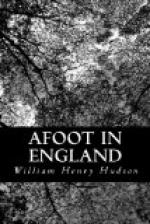With this question, however, we need not concern ourselves. To me, after stumbling by chance on the little church in that solitary woodland place, the story of its origin was accepted as true; no doubt it had come down unaltered from generation to generation through all those centuries, and it moved my pity yet was a delight to hear, as great perhaps as it had been to listen to the beautiful chimes many times multiplied from the wooded hill. And if I have a purpose in this book, which is without a purpose, a message to deliver and a lesson to teach, it is only this—the charm of the unknown, and the infinitely greater pleasure in discovering the interesting things for ourselves than in informing ourselves of them by reading. It is like the difference in flavour in wild fruits and all wild meats found and gathered by our own hands in wild places and that of the same prepared and put on the table for us. The ever-varying aspects of nature, of earth and sea and cloud, are a perpetual joy to the artist, who waits and watches for their appearance, who knows that sun and atmosphere have for him revelations without end. They come and go and mock his best efforts; he knows that his striving is in vain—that his weak hands and earthy pigments cannot reproduce these effects or express his feeling—that, as Leighton said, “every picture is a subject thrown away.” But he has his joy none the less; it is in the pursuit and in the dream of capturing something illusive, mysterious, and inexpressibly beautiful.
Chapter Two: On Going Back
In looking over the preceding chapter it occurred to me that I had omitted something, or rather that it would have been well to drop a word of warning to those who have the desire to revisit a place where they have experienced a delightful surprise. Alas! they cannot have that sensation a second time, and on this account alone the mental image must always be better than its reality. Let the image—the first sharp impression—content us. Many a beautiful picture is spoilt by the artist who cannot be satisfied that he has made the best of his subject, and retouching his canvas to bring out some subtle charm which made the work a success loses it altogether. So in going back, the result of the inevitable disillusionment is that the early mental picture loses something of its original freshness. The very fact that the delightful place or scene was discovered by us made it the shining place it is in memory. And again, the charm we found in it may have been in a measure due to the mood we were in, or to the peculiar aspect in which it came before us at the first, due to the season, to atmospheric and sunlight effects, to some human interest, or to a conjunction of several favourable circumstances; we know we can never see it again in that aspect and with that precise feeling.




